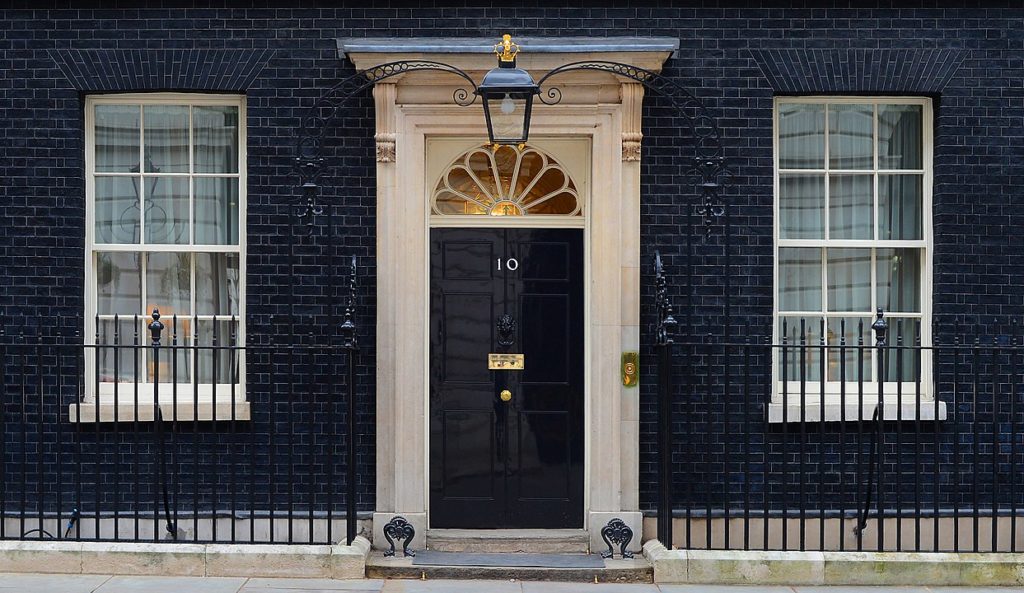
I learned this today. The first prime minister of the UK to live in 10 Downing Street was Sir Robert Walpole in 1735.
10 Downing Street is located in the City of Westminster, in London. In 960, an abbey was built there, and the area became known as “west minster” to differentiate it from the “east minster”, which was St. Paul’s cathedral. This abbey would become the Westminster Abbey that is still standing today. Edward the Confessor added to the abbey in the 11th century and built his palace there. He wanted to move power and wealth away from the old City of London. By doing this, he ensured that Westminster would become the center of government in England.
Henry VIII made Westminster even more important by building his royal residence there. It was called Whitehall Palace and was the biggest palace in Europe until the Palace of Versailles was built. Whitehall palace no longer exists, but the name Whitehall has been given to the street where many British government buildings are located.
In 1581, Queen Elizabeth I leased a house to Sir Thomas Knyvet. This was the first house built on the land that is now 10 Downing Street. When he died, his niece lived in the house for the next 40 years. Her name was Elizabeth Hampden. The house became known as Hampden House.
Sir George Downing, who gave his name to the street, was a soldier, a spy, a property developer, and not a very nice person. He bought the lease on some land to the south of St. James’s Park. He planned to build a row of terraced townhouses. Whatever houses he built would be very close to the government and he knew they would be popular. However, the Hampdens wouldn’t give up the lease on their house and Downing had to wait 30 years before he could start building.
Christopher Wren, the architect of the rebuilt St. Paul’s Cathedral, designed Downing’s houses, but Downing built the houses as cheaply as possible with shallow foundations. Between 1682 and 1684 all of the houses were built.
The original houses on Downing Street didn’t have street numbers. Houses were usually known by their occupant, such as Hampden house. The first instance of using street numbers in the UK was in 1708. The custom slowly increased through the 18th century and took off after the Industrial Revolution. As more people started to live in London, it became more necessary of keeping track of them. The first house on Downing Street was numbered in 1779.
King George II gave the house on Downing Street to Robert Walpole in 1735 and he moved in on 22nd September. Before him, the house was occupied by the Countess of Yarmouth, Lord Lansdowne, the Earl of Grantham, and someone called Mr. Chicken.
The King tried to give the house directly to Walpole, but he refused it and requested that it be kept as the official residence of the First Lord of the Treasury. The First Lord of the Treasury is basically the person in charge of the crown’s treasury and is the prime minister.
The house at 10 Downing Street was combined with another house behind it before Walpole moved in. The attached house was the main house and the front on Downing Street was basically a passageway to the main house. The Walpoles lived at the back.
After Walpole left, his successors didn’t live there. They preferred their own houses. Only George Granville (1763 to 1765) and Lord North (1770 to 1782) lived there. Lord North carried out extensive renovations. He was responsible for the lion’s head door knocker and the lamp above the front door.
Nobody lived there again until Viscount Goderich (1827 to 1828) and he did some more redecorating. Then nobody lived there until Benjamin Disraeli moved in in 1874. He said that it was “dingy and decaying”. The whole area had become decrepit. There were gin parlors, brothels, and crime had grown worse. Disraeli managed to persuade the government to pay for a complete refurbishment. Since him, only one prime minister (Lord Salisbury) has not lived in 10 Downing Street.
Each prime minister that lived there made some changes. William Gladstone introduced electric lights. Ramsay MacDonald installed the library that each prime minister adds to. Neville Chamberlain had central heating installed.
By 1960, the building was not in the best of shape. It was bomb damaged from World War 2, it had subsidence, sloping walls, twisted door frames, and it was costing a lot of money to fix it every year. The government decided to rebuild it. Number 10 was rebuilt, trying to keep as much of the original building together as possible. In the process, it was also discovered that the outside of the building was yellow rather than black. It had become black thanks to 200 years of pollution. When they rebuilt it, they painted the bricks black anyway to make it look the same.
In 1991, the IRA launched a mortar into the garden of number 10, causing extensive damage. It was from this date that Downing Street was closed off for the sake of security.
The building was remodeled again in 2007 and to bring it up to date, leaving the Number 10 Downing Street that we can see today.
So, the original house on the land was called Hampden House. George Downing managed to buy the land and built houses there. George II gave one of the houses to Robert Walpole as the official residence of the prime minister in 1735. And that is what I learned today.
Photo By Sergeant Tom Robinson RLC – https://commons.wikimedia.org/w/index.php?curid=28014902
Sources
https://en.wikipedia.org/wiki/10_Downing_Street
https://en.wikipedia.org/wiki/City_of_Westminster
https://www.gov.uk/government/history/10-downing-street
https://www.historic-uk.com/HistoryUK/HistoryofBritain/The-History-of-10-Downing-Street/
https://en.wikipedia.org/wiki/Westminster
https://londonist.com/london/secret/secrets-of-the-borough-of-westminster
https://westminster-abbey.org/about-the-abbey/history/history-of-westminster-abbey
https://en.wikipedia.org/wiki/Palace_of_Westminster
https://en.wikipedia.org/wiki/Palace_of_Whitehall
https://en.wikipedia.org/wiki/Sir_George_Downing,_1st_Baronet
https://www.quora.com/Who-occupies-the-houses-from-1-to-9-Downing-Street
